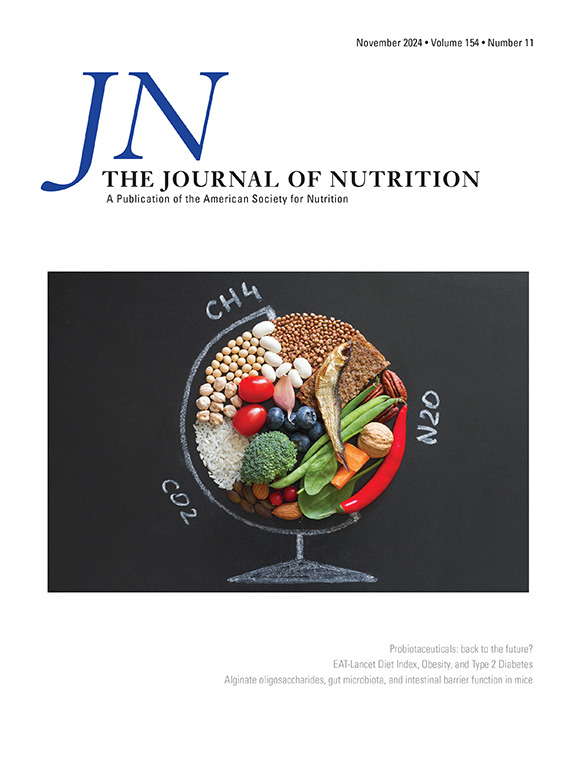一项大规模的营养和性别敏感家禽市场计划没有改善布基纳法索农村孕产妇和儿童的饮食:一项集群随机对照试验。
IF 3.7
3区 医学
Q2 NUTRITION & DIETETICS
引用次数: 0
摘要
背景:畜牧生产干预措施可以改善动物源性食品的消费和饮食多样性,从而可能改善微量营养素的充足性。目的:我们评估了SELEVER对孕产妇和儿童饮食结果的有效性,SELEVER是一项牲畜干预措施,旨在通过培训和市场促进来改善布基纳法索农村的饮食,以提高家禽生产;妇女赋权活动;营养和卫生行为会改变交流。方法:采用非盲法整群随机对照试验,随机分配30个社区为SELEVER组,30个社区为对照组,其中15个社区为窄样本对照组。在每个公社的两个村随机抽取15户;其中12人被纳入窄样本。在广泛的样本中,我们使用ANCOVA来评估SELEVER对基线时2-4岁的指数儿童及其照顾者的饮食多样性的有效性,以及对测量时6-23个月的兄弟姐妹的最低可接受饮食的有效性。在狭窄的样本中,我们采用差比差法来评估SELEVER对维生素A、铁和锌充足摄入量(PA)的流行率和11种微量营养素的平均PA在指数儿童和照顾者中的有效性。结果:我们在宽样本中招募了1767名指数儿童,1766名照顾者和412名6-23个月大的兄弟姐妹,在窄样本中招募了1054名照顾者-儿童二联体。在广泛的样本中,在SELEVER社区中,项目活动的曝光率较高,但适度,对饮食知识和实践的影响有限,对饮食结果没有影响。窄样本对儿童锌PA有负作用(-26个百分点,P=0.020),对其他结局无影响。结论:侧重于提高营养食品的生产效率和需求的计划并没有改善微量营养素的充足性。实施战略和瓶颈可能限制了向更健康饮食产生可衡量转变所需的系统转型。该研究已在ISCRCTN注册中心注册(ISRCTN16686478);详情请浏览https://www.isrctn.com/ISRCTN16686478。本文章由计算机程序翻译,如有差异,请以英文原文为准。
A Large-Scale Nutrition- and Gender-Sensitive Poultry Market-Based Program Did Not Improve Maternal and Child Diets in Rural Burkina Faso: A Cluster-Randomized Controlled Trial
Background
Livestock production interventions can improve consumption of animal-source foods and diet diversity, which may lead to improved micronutrient adequacy.
Objectives
We assessed the effectiveness on maternal and child dietary outcomes of “Soutenir l’Exploitation Familiale pour Lancer l’Élevage des Volailles et Valoriser l’Économie Rurale” (SELEVER), a livestock intervention designed to improve diets in rural Burkina Faso through training and market facilitation to improve poultry production; females’ empowerment activities; and nutrition and hygiene behavior change communication.
Methods
For a nonblinded cluster-randomized controlled trial, we randomly assigned 30 communes to SELEVER and 30 communes to control, of which 15 communes served as control for a narrow sample. Fifteen households were randomly selected in 2 villages per commune; of which 12 were included in the narrow sample. In the wide sample, we used analyses of covariance to assess SELEVER’s effectiveness on dietary diversity in index children aged 2–4 y at baseline and in their caregivers, and on minimum acceptable diet in their siblings aged 6–23 mo at measurement. In the narrow sample, we used difference-in-difference to assess SELEVER’s effectiveness on vitamin A, iron, and zinc prevalence of adequate intakes (PA) and mean PA of 11 micronutrients in index children and caregivers.
Results
We enrolled 1767 index children, 1766 caregivers, and 412 siblings aged 6–23 mo at endline in the wide sample, and 1054 caregiver-child dyads in the narrow sample. In the wide sample, exposure to program activities was higher but moderate in SELEVER communities, with limited effects on dietary knowledge and practices and no effects on diet outcomes. The narrow sample showed a negative effect on zinc PA in children (–26 percentage points, P = 0.020), and no effect on other outcomes.
Conclusions
A program focused on improving the productivity of and demand for nutritious foods did not improve micronutrient adequacy. Implementation strategy and bottlenecks may have limited the system transformations needed to produce measurable shifts toward healthier diets.
Trial registration number
This study was registered at ISCRCTN with registration number ISRCTN16686478 (https://www.isrctn.com/ISRCTN16686478).
求助全文
通过发布文献求助,成功后即可免费获取论文全文。
去求助
来源期刊

Journal of Nutrition
医学-营养学
CiteScore
7.60
自引率
4.80%
发文量
260
审稿时长
39 days
期刊介绍:
The Journal of Nutrition (JN/J Nutr) publishes peer-reviewed original research papers covering all aspects of experimental nutrition in humans and other animal species; special articles such as reviews and biographies of prominent nutrition scientists; and issues, opinions, and commentaries on controversial issues in nutrition. Supplements are frequently published to provide extended discussion of topics of special interest.
 求助内容:
求助内容: 应助结果提醒方式:
应助结果提醒方式:


